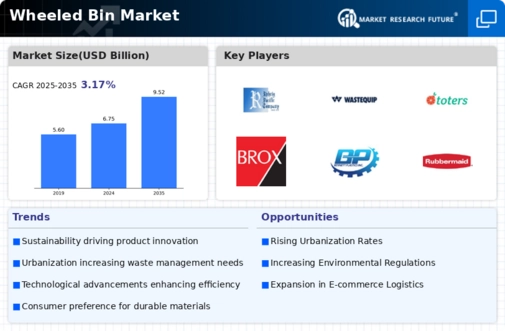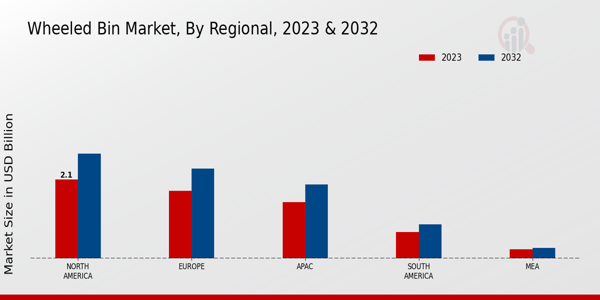Rising Urbanization
The Global Wheeled Bin Market Industry experiences a notable surge due to increasing urbanization. As more people migrate to urban areas, the demand for efficient waste management solutions escalates. Urban centers require robust waste collection systems to handle the growing volume of refuse generated by dense populations. This trend is particularly evident in developing nations, where urbanization rates are projected to rise significantly. Consequently, the Global Wheeled Bin Market is expected to reach a valuation of 6.75 USD Billion by 2024, reflecting the pressing need for effective waste management infrastructure in urban environments.
Expansion of E-commerce
The expansion of e-commerce is reshaping the Global Wheeled Bin Market Industry as online shopping generates substantial amounts of packaging waste. With the rise of home deliveries, there is an increasing need for efficient waste collection solutions to manage the resultant refuse. Retailers and logistics companies are recognizing the importance of proper waste disposal and are investing in wheeled bins to streamline their waste management processes. This trend is likely to contribute to the overall growth of the market, as businesses seek to enhance their sustainability efforts while managing the waste generated from e-commerce activities.
Environmental Regulations
Stringent environmental regulations are driving the Global Wheeled Bin Market Industry as governments worldwide implement policies aimed at reducing waste and promoting recycling. These regulations often mandate the use of specific waste containers, including wheeled bins, to facilitate proper waste segregation and collection. For instance, many countries are adopting laws that require municipalities to provide standardized waste bins to enhance recycling efforts. This regulatory landscape not only fosters market growth but also encourages manufacturers to innovate in design and functionality, ensuring compliance with evolving standards. As a result, the market is poised for growth, potentially reaching 9.52 USD Billion by 2035.
Market Growth Projections
The Global Wheeled Bin Market Industry is projected to experience robust growth over the coming years. With a market valuation of 6.75 USD Billion in 2024, it is anticipated to reach 9.52 USD Billion by 2035, reflecting a steady increase in demand for wheeled bins across various sectors. The compound annual growth rate (CAGR) of 3.18% from 2025 to 2035 indicates a sustained interest in efficient waste management solutions. This growth trajectory is supported by various factors, including urbanization, regulatory changes, and technological advancements, which collectively drive the need for innovative wheeled bin designs and functionalities.
Technological Advancements
Technological advancements play a pivotal role in shaping the Global Wheeled Bin Market Industry. Innovations in materials and design have led to the development of more durable and user-friendly wheeled bins. For example, the introduction of smart bins equipped with sensors for monitoring waste levels is gaining traction in urban areas. These bins can optimize collection routes, thereby reducing operational costs for waste management companies. Additionally, advancements in recycling technologies are prompting the need for specialized wheeled bins that cater to specific waste streams. This trend indicates a shift towards more efficient waste management solutions, aligning with the projected CAGR of 3.18% for 2025-2035.
Growing Awareness of Sustainability
The Global Wheeled Bin Market Industry is significantly influenced by the growing awareness of sustainability among consumers and businesses alike. As environmental consciousness rises, there is an increasing demand for products that support sustainable waste management practices. Companies are now prioritizing eco-friendly materials in the production of wheeled bins, appealing to environmentally conscious consumers. This shift is evident in the rise of biodegradable and recyclable bin options. Furthermore, educational campaigns on waste reduction and recycling are fostering a culture of sustainability, which in turn drives the demand for wheeled bins designed for effective waste segregation and management.






















Leave a Comment